| |
|
There were Castes, Classes, Masses,
Races and Saabs |
|
At the start of the war, the Indian
regimental ranks numbered 2,390,561, none of them a ‘Gentleman'
The Indian ‘Gentlemen', the ones who had gone to college, would be
recruited only after the war when commissioned ranks were offered to
Indians. Till the end of World War I it was the muscular, but barely
literate ones who were recruited into lower ranks and at the most for
viceroy's commission. |
When he dismounted his horse and walked into Jerusalem like a
pilgrim in October 1917, General Edmund Allenby was performing a feat
that even England's greatest Warrior-king, Richard the Lionheart,
couldn't. Commanding two divisions of doughty Indian soldiers (Hindus,
Muslims, Sikhs and Christians) Allenby became the first Christian
commander after the First Crusade to defeat a Muslim army and enter the
Holy City. None mutinied, not even the ‘Mussalman' battalions! The
politics of religion would be played afterwards with the Khilafat
Movement.
A few days earlier, the 6th Gurkhas had become the only Allied
unit to cross into the Turk and German held Gallipoli. Bill, a young
subaltern in the Royal Warwickshire regiment, watched the daring charge
in awe, and applied for a transfer to the Indian Army at a lower pay.
Years later, Field Marshal William (Bill) Slim would command the entire
Indian Army, and become one of India's most fondly remembered army
chiefs since Stringer Lawrence raised the Madras Army, and thus the
Madras regiment, in 1748.
Such acts by young British gentlemen-officers made the imperial-minded
British rulers in India rethink about Indians, and the feudal-minded
Indian gentry rethink about the army in which sons of their serfs had
been serving.The viceroy's commission would later be called the
junior commission, a class of semi-officers not found in any other army
today. Just as the British officers had to call every viceroy
commissioned officer saab, even today officers address the junior
commissioned officers, who are below them in rank, as saab. |
 |
| Even the President, the supreme commander, has to address a subedar-major
as saab. |
General Sir Edmund Allenby - 1914 |
| The viceroy's commission would later be called the junior
commission, a class of semi-officers not found in any other army today.
Just as the British officers had to call every viceroy commissioned
officer saab, even today officers address the junior commissioned
officers, who are below them in rank, as saab. Even the President, the
supreme commander, has to address a subedar-major as saab. |
|
6th Gurkhas - Gallipoli |
6th Gurkhas - Mesopatamia |
By the time the war ended, 60,000 didn't come back; they were buried
or lost in France, Greece, North Africa, Palestine, and of course
Mesopotamia; another 70,000 came back minus a limb or two or permanently
crippled.
So, it was the case with the Empires. Five Empires had gone to
war in 1914, the British, German, Russian, Austro-Hungarian and the
Ottoman Turks. One survived. It took another 30 years and another World
War to bring about the end of history's last and mightiest empire. |
|
129th Baluch - Firing Exercise |
Indian Troops World War I - France |
As soon as the war was proclaimed, Viceroy Hardinge committed two
infantry and two cavalry divisions to Britain's war effort. India had a
recruitable manpower (men aged 18 to 50). Congress leader Madan Mohan
Malviya promised Hardinge that India would grudge “no sacrifice of men
and money in order that the British armies shall triumph”.
The most pressing theatre at the start of the war was France. The
British Expeditionary Force there was losing out to the better armed
Germans after fighting for two months, when the Meerut and Lahore
divisions landed at Marseilles in October and, as Charles Chenevix
Trench wrote in The Indian Army and The King's Enemies 1900-1947,
“practised for a day or two with the short Lee-Enfield rifle which was
new to them, and were entrained for the front.” During the First World
War, the 129th Baluch served on the Western Front in France and
Belgium, where they became the first Indian regiment to attack the
Germans. The Baluch Regiment (now with Pakistan) charged into
Ypres where Sepoy Khudadad Khan, a Punjabi Muslim, became the first
Indian to win the Victoria Cross. |
|
 |
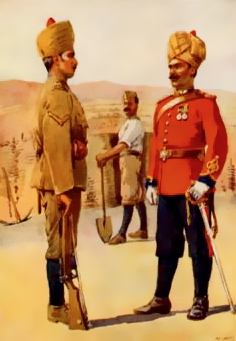 |
|
40th Pathans |
Bengal Sappers |
The Bengal Sappers, an engineering unit still serving the
Indian Army, fought as emergency infantry, and lost all its British
officers. Officers led from the front. Lt. Colonel E.R.R. Swiney led the
newly raised 39th Garhwal Rifles (still serving as Garhwal
Rifles), wearing Gurkha uniforms and carrying Khukri (because earlier
they used to be recruited into the Gurkha regiments), in a brilliant
flank attack on the Germans in Neuve Chapelle where Naik Darwan Singh
Negi won India's second Victoria Cross. Short of horses, the Poona
Horse (earlier 17th Queen Victoria's own cavalry and now an armored
regiment) fought on foot, with no winter clothes.
From France, the 129th Baluch and 40th Pathans (their successor
units are now in the Pakistani army) went to East Africa. Their
reputation had preceded them. Paul von Lettow-Vorbeck, the German
general who waited for them in East Africa and who was respected even by
the British as Erwin Rommel would be in the next war, noted in his diary
that the Indians “are without a doubt very good”. |
|
 |
 |
|
40th Pathans Attacking Germans Near Ypres - April
26th, 1915 |
40th Pathans in Regimental Dress . . . circa
1914 |
The disaster was Mesopotamia, which ranks as one of the two worst
humiliations (the other was at the hands of the Afghans, 1839-42)
suffered by the British Empire in its two and a half centuries of
existence. The military objective was small, safeguard the oil wells
near Basra from the Turks. An expeditionary force, under Major General
Charles Townshend, who had brilliantly defended Chitral in the northwest
25 years earlier, was sent from India. Having taken Basra, Townshend got
ambitious. Why not the ancient town of Ctesiphon? Or even the fabled
Baghdad, the city of the Arabian Nights?
It looked easy. There was no major Turkish resistance, but what
Townshend ignored was that he was stretching his supply lines thin. He
took Kut-al Amara where Turkish general Nuruddin tried to block him. The
24th and 66th Punjabis and 117th Mahrathas, whose
successor regiments are still in the Indian Army without the numerals,
stormed into Ctesiphon. Townshend wisely retreated to Kut. Nuruddin and
struck again, just once, and laid siege to Kut. And there perished
thousands, without food, medicines or even water. Their names are etched
on the stones of Delhi's India Gate. |
|
 |
 |
|
117 Mahrattas - Banner |
Jawans of the Maratha Light Infantry (Today) |
| Finally, Sir Stanley Maude redeemed the Indian and British honor. He
took back Mesopotamia, leading his Sikhs, Mahrathas and Gurkhas, ably
assisted by Madras and Bengal Sappers, all still in the Indian Army
today. The Delhi Cantonment still has Maude Lines, though the road signs
near ‘Cavalary' Road say ‘Maudelines'. |
|
Sikh Infantry at Festubert . . . circa 1915 |
Sikhs Attack German Trenches at Leper - April 20th,
1915 |
Edmund ‘Bull' Allenby's ride into Palestine, commanding the 4th and
5th Indian divisions, along with an Australian and a New Zealand
division, against a formidable line-up of Turks and Germans was
history's last great cavalry campaign. The two divisions were mostly
composed of 2nd Lancers, 29th Lancers, 6th Cavalry, 38th Central India
Horse, 36th Jacob's Horse (Scinde Horse), 19th Lancers, Jodhpur Lancers,
9th Hodson's Horse (raised by the notorious William Hodson who shot the
last Mughal emperor Bahadur Shah Zafar's unarmed sons in cold blood in
1857), 20th Deccan Horse, Mysore Lancers, 18th Lancers, 34th Poona Horse
and Hyderabad Lancers. Most of these units were later amalgamated into
armored regiments of the Indian Army.
They marched from Nazareth to Damascus where Risaldar Nur Ahmed of
Hodson's Horse made hundreds of Turks surrender to him. Poona Horse
surrounded a motor-car carrying a European wearing Arab clothes. They
took him for a German spy and grilled him in Urdu. The man shouted back
in Arabic. British officers reached the scene and further questioned the
‘spy'.
Spying he was, but for the British. He would later employ Pathans from
the Indian Army for several of his famous raids. His name was T. E.
Lawrence. |
|
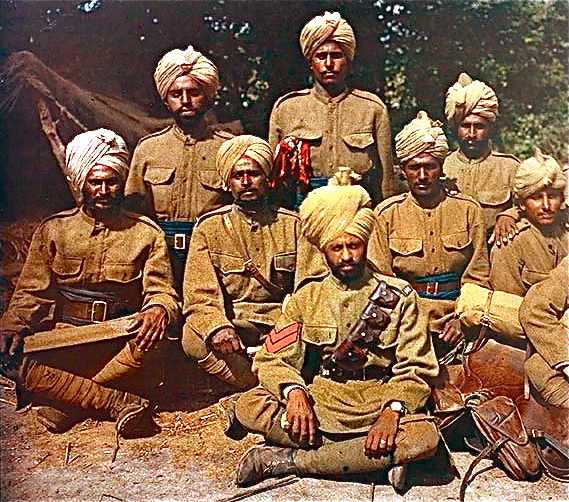 |
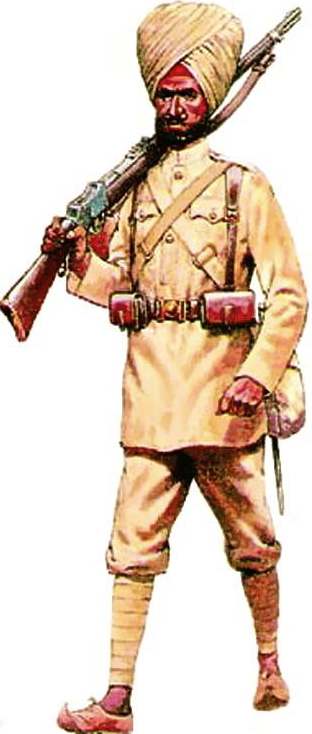 |
The war changed India, the way it was governed and the way it waged
its wars. The British began to take the Indians more seriously as rulers
and commanders. The Montagu-Chelmsford reforms of 1919, though not very
successful, gave more civil powers to Indians. Three committees
overhauled the army. They recruited college-bred young Indian gentlemen
as officers. Thousands enlisted.
The two reforms and a few on the same lines later would save India from
chaos and civil wars many years later. In about three decades, when the
British Empire had to leave India, it left an incredibly huge class of
officers who would lead their men from the front in war after war. |
|
The Great War
(June 28th, 1914 to June 28th, 1919) |
|
Fighter aircraft, tanks, submarines,
heavy artillery: the horrors of warfare between 1914 and 1918 were a
crucible for deadly technological innovation, including the poison gas
that came to symbolize the barbarity of the conflict |
|
World War I broke out in 1914, no European army was
prepared for the heavily defensive conflict that was to define the war
years |
| Major innovation came at sea. Germany had all but given up trying to
compete with Britain above the waterline, but turned its attention to
the U-boat that it started building after the outbreak of war. Britain's
naval blockade in late 1914 triggered the first submarine warfare in the
North Sea.
By 1917, Germany had set itself a target of sinking 600,000 tonnes of
shipping every month, and was at first successful. But the use of
convoys to protect ships was eventually able to overwhelm the U-boat strategy. |
| None of the Great War's weapons proved decisive. It was ultimately
the involvement of the vast US industrial war machine, largely involved
as a result of the sinking of the Lusitania (May 7th, 1915), that tipped the
scales against Germany. But the firepower and technologies that emerged
during the Great War were to define most of the conflicts since then. |
|
German Maxim Machinegun |
Vickers Machinegun |
|
"Clothes-line" |
Note the density and length of the
barbs, quite unlike anything used today
Dangerous and impenetrable were such defenses in WWI |
Faced with a wall of bullets from machine guns and a
deluge of shells from above, a veritable four-year "storm of steel",
armies on all sides dug down into trenches and relied on a formidable
array of defenses.
Barbed wire (invented in the United States for fencing cattle) became
ubiquitous. Thousands of infantrymen lost their lives entangled in the
wires, earning them the grim nickname of "clothes-line" among French
veterans.
Britain and France made more attempts than Germany to break through
enemy lines on the Western Front.
The Germans focused on perfecting their heavy artillery. Previously
packed with shrapnel, shells were now filled with high explosives that
could flatten defenses and maximize casualties. Smoke shells and more
accurate targeting became major priorities as the war progressed. |
 |
|
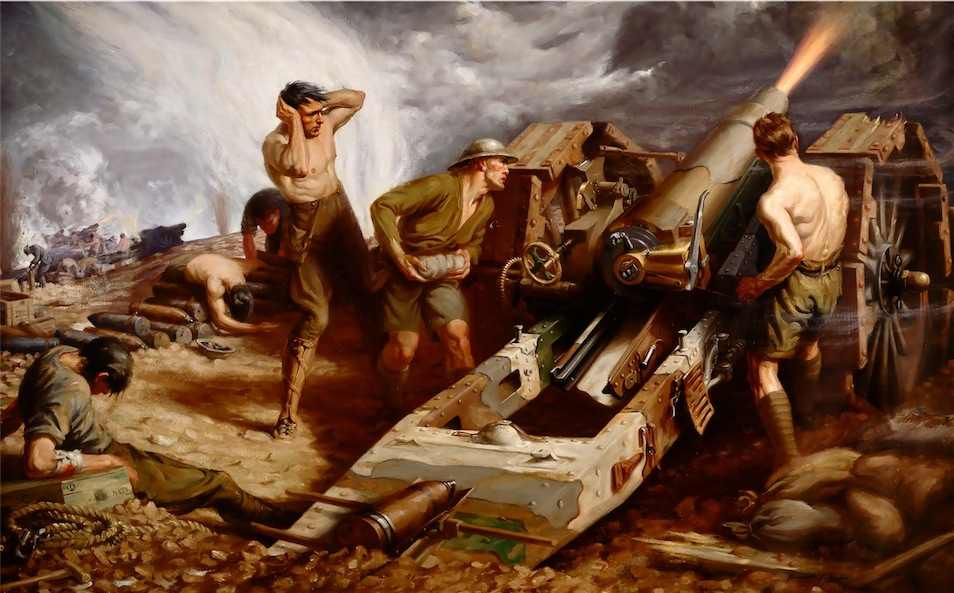 |
| The British unveiled a new caterpillar-tracked armored vehicle
called the tank, in 1914. Designed to break the stalemate of trench
warfare, tanks made their first faltering appearance at the Battle of
Flers-Courcelette, September 15th, 1916. Initially clumsy, plodding and
prone to frequent break-downs, it was quickly perfected to become a key
tool for penetrating enemy lines in the closing stages of the war. |
|
British Mark IV Tank (1917-1918) |
British Whippet Tank (1917-1918) |
|
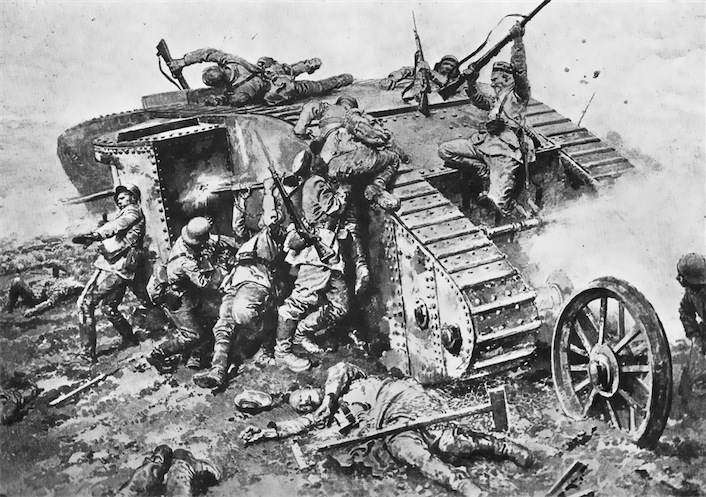 |
In the early years, Germany was largely content to sit back and wait
for attrition to take its toll on the enemy. Indeed, it carried out only
one major attack on the Western front in 1915, at Ypres, in Belgium; and
this only to test a brutal new weapon: Chlorine Poison Gas.
Total war destroyed any moral inhibition in the development of weaponry.
The French and Belgian soldiers at Ypres in April 1915 saw thick smoke
rising, "then a cloud of green, about 10 metres high, particularly thick
at the base, coming towards us, pushed by the wind. Almost immediately,
we were suffocating," recalled a French lieutenant, Jules-Henri
Guntzberger.
Gas brought a previously unknown level of terror to soldiers on the
front line. Panicked, blinded and choking, thousands died in agony.
The horror of poison gas would permanently scar the collective
imagination.
But it actually had a minimal impact on the outcome of World War I.
Soldiers learned to cover their faces in wet handkerchiefs, soon
supplanted by goggles, canvas masks and a medical antidote. The lethal
effectiveness of gas was further blunted by the public revulsion it
stirred on the home front. In the end, gas attacks caused less than one
percent of the deaths in the war. |
|
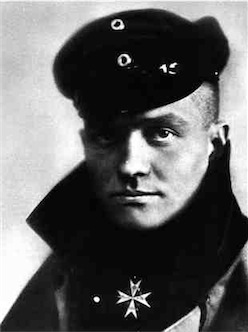 |
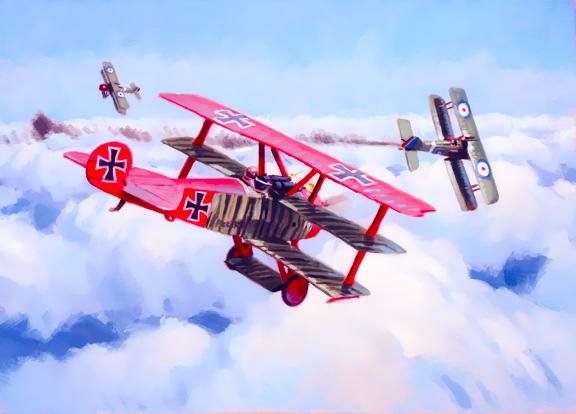 |
|
Baron Manfred von Richthofen |
The Red Baron |
Another danger came from the sky. Combat Aviation was still in its
infancy in 1914, but the war triggered a rapid industrial mobilization
that meant France alone had some 3,700 aircraft by the end of
hostilities. Verdun, in eastern France, was host to the world's first
large-scale aerial battle.
"The Great War may have been the quintessential land battle, but it also
highlighted a strategic concept that would dominate conflicts in the
20th century: the importance of airpower as a prerequisite for any
successful major ground attack," wrote French historian Jean-Yves Le
Naur.
Initially, the air was a place for surveillance, helped by improvements
in mapping, aerial photography and communications. The dogfights --
which alone in the conflict retained some vestige of the romantic war
fighting of the past -- were primarily geared towards denying the enemy
these reconnaissance opportunities.
Bombardments emerged only gradually, most notably in the form of the
German dirigible balloons named after their inventor, Graf von Zeppelin.
They were first used to attack Antwerp in August 1914, and then deployed
for night raids in the United Kingdom from January 1915.
By 1917, long-range German Gotha bombers were carrying out daylight
raids on London, and the United Kingdom had developed its Royal Airforce
for retaliatory attacks in the Rhine, but this technology's deadly
potential would not be realized until later. |
|
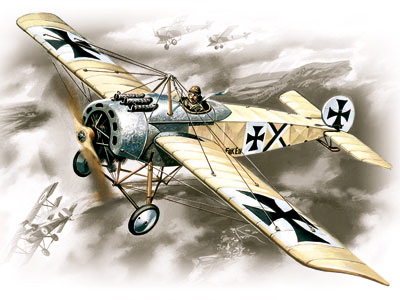 |
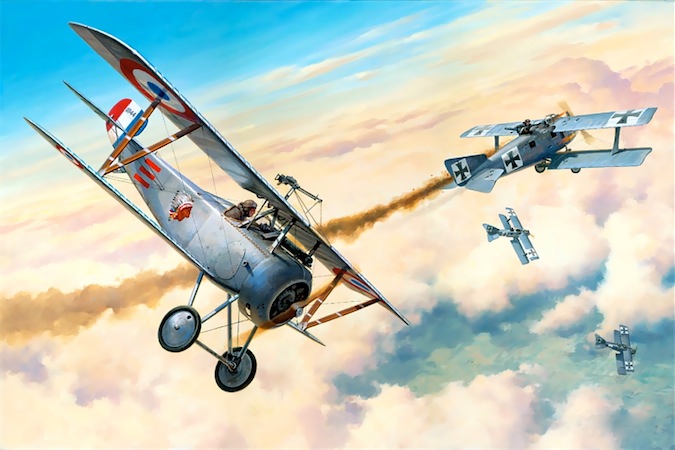 |
|
Fokker German Fighter |
Dogfight |
|